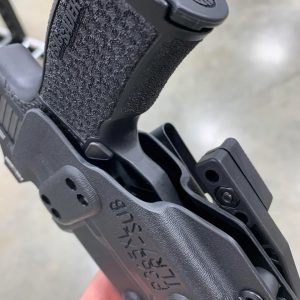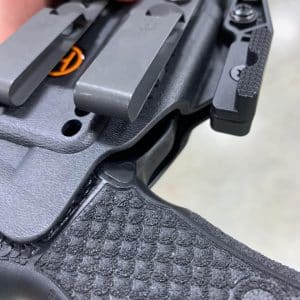


Light-bearing holsters, clearance, access and negligent discharge risks
Originally posted on Reddit, here.
There are two main variables in each LB holster design: The profile/dimensions of the light itself, and the outline of the holster that determines the size of the opening at the mouth of the holster where the holster profile intersects the light channel. I’ve seen many holsters that have visibly oversized light channels that don’t match the profile or dimensions of the actual light, because the maker was adding generic “light-channel” shapes to their mold in order to provide the required clearance to allow the light to pass in and out of the holster. In addition, the profile of the holster can be cut in such a way that it allows an unnecessary degree of access to the channel near the trigger.
I don’t have any control of the shape of the light itself. Whatever its dimension are, my light-channel needs to be AT LEAST that large. The closer the channel is to being exactly the same size/shape as the light, the more protected the trigger will be, but the less forgiving the holster will be about alignment when you go to holster up which can increase the risk of pointing your gun at yourself if you have to wiggle it around, and take multiple “stabs” at the holster to get your gun in. If the holster mouth is a giant bucket, it’s EASY to get the gun/light aligned and seated, but the trigger is more exposed, because larger (and therefore a wider variety of) objects, can conceivably sneak into the light channel and possibly interact with the trigger.
I like to have the profile of the holster match the profile of the trigger guard as closely as possible. If I cut too much material away, when viewed from the front, you can see through part of the trigger guard. If I leave too much material, the edge of the holster can interfere with building a full firing grip, and can abrade the side of your middle finger when you dry fire or practice your drawstroke.
Smaller lights (think TLR6) are so slim, that the effective light channel can be inaccessible to all but the smallest objects (thing sweatpants drawstring, jacket zipper pull or toggle), but those very small lights come at the cost of a significant dropoff in output, usefulness of light pattern, and robustness of controls. Larger, brighter lights (X300U, TLR1, PL350) have awesome output and big, positive controls, but force you to carry a much larger holster, with a much larger opening.
No one else but you can make the decision about your comfort level, and weapon lights are not mandatory for all concealed carriers, no matter what the internet may say. Some amount of trigger access/exposure is essentially unavoidable with a light-bearing holster. You can assess your own wardrobe and make changes (removing drawstrings, zipper pulls, toggles, etc) to reduce your chances of having a problem, but carrying a firearm is an inherently dangerous activity.
Pics are of our holster for P365XL w/ TLR7 Sub, to illustrate the light-channel opening and holster profile from several angles.







